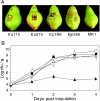Genetic differences between blight-causing Erwinia species with differing host specificities, identified by suppression subtractive hybridization
- PMID: 16963554
- PMCID: PMC1636173
- DOI: 10.1128/AEM.01159-06
Genetic differences between blight-causing Erwinia species with differing host specificities, identified by suppression subtractive hybridization
Abstract
PCR-based subtractive hybridization was used to isolate sequences from Erwinia amylovora strain Ea110, which is pathogenic on apples and pears, that were not present in three closely related strains with differing host specificities: E. amylovora MR1, which is pathogenic only on Rubus spp.; Erwinia pyrifoliae Ep1/96, the causal agent of shoot blight of Asian pears; and Erwinia sp. strain Ejp556, the causal agent of bacterial shoot blight of pear in Japan. In total, six subtractive libraries were constructed and analyzed. Recovered sequences included type III secretion components, hypothetical membrane proteins, and ATP-binding proteins. In addition, we identified an Ea110-specific sequence with homology to a type III secretion apparatus component of the insect endosymbiont Sodalis glossinidius, as well as an Ep1/96-specific sequence with homology to the Yersinia pestis effector protein tyrosine phosphatase YopH.
Figures

Similar articles
-
A polyphasic approach assigns the pathogenic Erwinia strains from diseased pear trees in Japan to Erwinia pyrifoliae.Lett Appl Microbiol. 2009 Mar;48(3):324-30. doi: 10.1111/j.1472-765X.2008.02535.x. Epub 2009 Jan 23. Lett Appl Microbiol. 2009. PMID: 19187512
-
Molecular comparison of pathogenic bacteria from pear trees in Japan and the fire blight pathogen Erwinia amylovora.Microbiology (Reading). 2001 Nov;147(Pt 11):2951-9. doi: 10.1099/00221287-147-11-2951. Microbiology (Reading). 2001. PMID: 11700346
-
Genome comparison of the epiphytic bacteria Erwinia billingiae and E. tasmaniensis with the pear pathogen E. pyrifoliae.BMC Genomics. 2010 Jun 22;11:393. doi: 10.1186/1471-2164-11-393. BMC Genomics. 2010. PMID: 20565991 Free PMC article.
-
Current Situation of Fire Blight in China.Phytopathology. 2023 Dec;113(12):2143-2151. doi: 10.1094/PHYTO-05-23-0170-RVW. Epub 2023 Dec 26. Phytopathology. 2023. PMID: 37505073 Review.
-
Functions and origin of plasmids in Erwinia species that are pathogenic to or epiphytically associated with pome fruit trees.Trees (Berl West). 2012;26(1):31-46. doi: 10.1007/s00468-011-0630-2. Epub 2011 Oct 11. Trees (Berl West). 2012. PMID: 25983394 Free PMC article. Review.
Cited by
-
A "repertoire for repertoire" hypothesis: repertoires of type three effectors are candidate determinants of host specificity in Xanthomonas.PLoS One. 2009 Aug 14;4(8):e6632. doi: 10.1371/journal.pone.0006632. PLoS One. 2009. PMID: 19680562 Free PMC article.
-
Complete genome sequence of the fire blight pathogen Erwinia pyrifoliae DSM 12163T and comparative genomic insights into plant pathogenicity.BMC Genomics. 2010 Jan 4;11:2. doi: 10.1186/1471-2164-11-2. BMC Genomics. 2010. PMID: 20047678 Free PMC article.
-
Assessment of the genetic diversity of Xanthomonas axonopodis pv. phaseoli and Xanthomonas fuscans subsp. fuscans as a basis to identify putative pathogenicity genes and a type III secretion system of the SPI-1 family by multiple suppression subtractive hybridizations.Appl Environ Microbiol. 2008 May;74(10):3295-301. doi: 10.1128/AEM.02507-07. Epub 2008 Mar 21. Appl Environ Microbiol. 2008. PMID: 18359831 Free PMC article.
-
Characterization of the SPI-1 Type III Secretion System in Pseudomonas fluorescens 2P24.Front Microbiol. 2021 Sep 21;12:749037. doi: 10.3389/fmicb.2021.749037. eCollection 2021. Front Microbiol. 2021. PMID: 34621260 Free PMC article.
-
Comparative Genomics of Erwinia amylovora and Related Erwinia Species-What do We Learn?Genes (Basel). 2011 Sep 15;2(3):627-39. doi: 10.3390/genes2030627. Genes (Basel). 2011. PMID: 24710213 Free PMC article.
References
-
- Bhattacharyya, A., S. Stilwagen, N. Ivanova, M. D'Souza, A. Bernal, A. Lykidis, V. Kapatral, I. Anderson, N. Larsen, T. Los, G. Reznik, E. Selkov, Jr., T. L. Walunas, H. Feil, W. S. Feil, A. Purcell, J.-L. Lassez, T. L. Hawkins, R. Haselkorn, R. Overbeek, P. F. Predki, and N. C. Kyrpides. 2002. Whole-genome comparative analysis of three phytopathogenic Xylella fastidiosa strains. Proc. Natl. Acad. Sci. USA 99:12403-12408. - PMC - PubMed
-
- Braun, P. G., and P. D. Hildebrand. 2005. Infection, carbohydrate utilization, and protein profiles of apple, pear, and raspberry isolates of Erwinia amylovora. Can. J. Plant Pathol. 27:338-346.
-
- Brown, N. F., and I. R. Beacham. 2000. Cloning and analysis of genomic differences unique to Burkholderia pseudomallei by comparison with B. thailandensis. J. Med. Microbiol. 49:993-1001. - PubMed
-
- Bugert, P., and K. Geider. 1995. Molecular analysis of the ams operon required for exopolysaccharide synthesis of Erwinia amylovora. Mol. Microbiol. 15:917-933. - PubMed
Publication types
MeSH terms
Substances
LinkOut - more resources
Full Text Sources
Molecular Biology Databases
Miscellaneous

